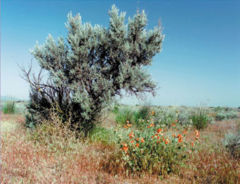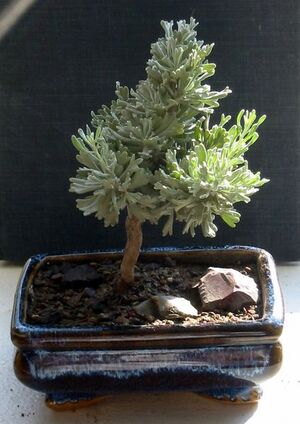Artemisia tridentata: Difference between revisions
No edit summary |
No edit summary |
||
| Line 1: | Line 1: | ||
{{SPlantbox | |||
|genus=Artemisia | |||
|species=tridentata | |||
|Temp Metric=°F | |||
|jumpin=If this plant info box on watering; zones; height; etc. is mostly empty you can click on the edit tab and fill in the blanks! | |||
|image=Upload.png | |||
|image_width=240 | |||
}} | |||
{{Inc| | |||
Artemisia tridentata, Nutt. Sage Brush. Shrubby, reaching height of 12 ft. although often only a foot high, branchy, canescent: Lvs. wedge-shaped, 3-7-toothed or lobed, truncate at the summit, the uppermost ones narrower: heads 5-8-fld. Plains, W. Intro. 1881. | |||
}} | |||
{{redirect|Sagebrush|other uses of the word|Sagebrush (disambiguation)}} | {{redirect|Sagebrush|other uses of the word|Sagebrush (disambiguation)}} | ||
| Line 21: | Line 33: | ||
}} | }} | ||
'''''Artemisia tridentata''''' ('''Sagebrush''', '''Big Sagebrush''', '''Common Sagebrush''', '''Blue Sagebrush''', or '''Black Sagebrush''') is a [[shrub]] or small [[tree]] from the family [[Asteraceae]]. Some botanists treat it in the [[segregate (taxonomy)|segregate]] genus ''Seriphidium'', as ''S. tridentatum'' (Nutt.) W. A. Weber, but this is not widely followed. The name | '''''Artemisia tridentata''''' ('''Sagebrush''', '''Big Sagebrush''', '''Common Sagebrush''', '''Blue Sagebrush''', or '''Black Sagebrush''') is a [[shrub]] or small [[tree]] from the family [[Asteraceae]]. Some botanists treat it in the [[segregate (taxonomy)|segregate]] genus ''Seriphidium'', as ''S. tridentatum'' (Nutt.) W. A. Weber, but this is not widely followed. The name "sagebrush" is also used for several related members of the genus ''[[Artemisia (plant)|Artemisia]]'', such as [[Artemisia californica|California Sagebrush]] (''Artemisia californica''). | ||
It is a coarse, hardy silvery-grey bush with yellow [[flower]]s and grows in arid sections of the [[American West|western]] [[United States]]. It is the primary vegetation across vast areas of the [[Great Basin]] desert. Along rivers or in other relatively wet areas, sagebrush can grow as tall as 3 m (10 feet), but is more typically 1-2 m tall. | It is a coarse, hardy silvery-grey bush with yellow [[flower]]s and grows in arid sections of the [[American West|western]] [[United States]]. It is the primary vegetation across vast areas of the [[Great Basin]] desert. Along rivers or in other relatively wet areas, sagebrush can grow as tall as 3 m (10 feet), but is more typically 1-2 m tall. | ||
| Line 39: | Line 51: | ||
[[Image:Young sagebrush.JPG|thumb|A young sagebrush grown as [[bonsai]], showing the typical leaf configuration]] | [[Image:Young sagebrush.JPG|thumb|A young sagebrush grown as [[bonsai]], showing the typical leaf configuration]] | ||
Sagebrush leaves compare favorably to [[alfalfa]] for [[livestock]] [[nutrition]] value. However, they also contain oils that are toxic to the [[Symbiosis|symbiotic]] [[bacterium|bacteria]] in the [[rumen]] of most [[ruminant]]s. These oils have the greatest effect on [[cattle]]. Cattle that resort to sagebrush due to the lack of other [[fodder]] in the winter often freeze to death before starving, as they rely in large part on the heat of their [[digestion|digestive]] action for warmth. Ranchers call this condition | Sagebrush leaves compare favorably to [[alfalfa]] for [[livestock]] [[nutrition]] value. However, they also contain oils that are toxic to the [[Symbiosis|symbiotic]] [[bacterium|bacteria]] in the [[rumen]] of most [[ruminant]]s. These oils have the greatest effect on [[cattle]]. Cattle that resort to sagebrush due to the lack of other [[fodder]] in the winter often freeze to death before starving, as they rely in large part on the heat of their [[digestion|digestive]] action for warmth. Ranchers call this condition "hollow belly". [[Sheep]] can tolerate moderate consumption of sagebrush leaves, especially the fresh spring buds. [[Pronghorn]] are the only large [[herbivore]] to browse sagebrush extensively. As pronghorn are the only remaining large herbivore that [[Evolution|evolved]] along with sagebrush ([[deer]] are a more recent arrival from [[Asia]]), this is not surprising. There is speculation that some of the herbivores that went extinct in [[North America]] at the end of the [[Pleistocene]] such as the [[Ground Sloth]] or the American [[Camel]] were also capable of browsing sagebrush. | ||
Sagebrush is not fire-tolerant and relies on wind-blown seeds from outside the burned area for re-establishment. This is in contrast to many of the other plants which share its habitat, such as [[Rabbitbrush]], [[Ephedra (genus)|Ephedra]] and bunchgrasses, which can root-sprout after a fire. [[Downy brome|Cheatgrass]] has invaded much of the sagebrush habitat, and if left unchecked could possibly create a fire cycle that is too frequent to allow sagebrush to re-establish itself. | Sagebrush is not fire-tolerant and relies on wind-blown seeds from outside the burned area for re-establishment. This is in contrast to many of the other plants which share its habitat, such as [[Rabbitbrush]], [[Ephedra (genus)|Ephedra]] and bunchgrasses, which can root-sprout after a fire. [[Downy brome|Cheatgrass]] has invaded much of the sagebrush habitat, and if left unchecked could possibly create a fire cycle that is too frequent to allow sagebrush to re-establish itself. | ||
Revision as of 11:46, 26 January 2010
| Artemisia tridentata subsp. var. | ||||||||||||||||||||||||||||||||||||||||||||||||||||||||
|---|---|---|---|---|---|---|---|---|---|---|---|---|---|---|---|---|---|---|---|---|---|---|---|---|---|---|---|---|---|---|---|---|---|---|---|---|---|---|---|---|---|---|---|---|---|---|---|---|---|---|---|---|---|---|---|---|

|
|
| ||||||||||||||||||||||||||||||||||||||||||||||||||||||
| ||||||||||||||||||||||||||||||||||||||||||||||||||||||||
| Standard Cyclopedia of Horticulture |
|---|
|
Artemisia tridentata, Nutt. Sage Brush. Shrubby, reaching height of 12 ft. although often only a foot high, branchy, canescent: Lvs. wedge-shaped, 3-7-toothed or lobed, truncate at the summit, the uppermost ones narrower: heads 5-8-fld. Plains, W. Intro. 1881.
|
| Artemisia tridentata secure Fossil range: {{{fossil_range}}}
| ||||||||||||||||||||||||||||||||||||||||||||||||||||||||||||||||||
|---|---|---|---|---|---|---|---|---|---|---|---|---|---|---|---|---|---|---|---|---|---|---|---|---|---|---|---|---|---|---|---|---|---|---|---|---|---|---|---|---|---|---|---|---|---|---|---|---|---|---|---|---|---|---|---|---|---|---|---|---|---|---|---|---|---|---|
 Sagebrush, Washington State | ||||||||||||||||||||||||||||||||||||||||||||||||||||||||||||||||||
| Plant Info | ||||||||||||||||||||||||||||||||||||||||||||||||||||||||||||||||||
| ||||||||||||||||||||||||||||||||||||||||||||||||||||||||||||||||||
| Scientific classification | ||||||||||||||||||||||||||||||||||||||||||||||||||||||||||||||||||
| ||||||||||||||||||||||||||||||||||||||||||||||||||||||||||||||||||
| [[{{{diversity_link}}}|Diversity]] | ||||||||||||||||||||||||||||||||||||||||||||||||||||||||||||||||||
| {{{diversity}}} | ||||||||||||||||||||||||||||||||||||||||||||||||||||||||||||||||||
| Binomial name | ||||||||||||||||||||||||||||||||||||||||||||||||||||||||||||||||||
| Artemisia tridentata Nutt. | ||||||||||||||||||||||||||||||||||||||||||||||||||||||||||||||||||
| Trinomial name | ||||||||||||||||||||||||||||||||||||||||||||||||||||||||||||||||||
| {{{trinomial}}} | ||||||||||||||||||||||||||||||||||||||||||||||||||||||||||||||||||
| Type Species | ||||||||||||||||||||||||||||||||||||||||||||||||||||||||||||||||||
| {{{type_species}}} | ||||||||||||||||||||||||||||||||||||||||||||||||||||||||||||||||||
| {{{subdivision_ranks}}} | ||||||||||||||||||||||||||||||||||||||||||||||||||||||||||||||||||
| [[Image:{{{range_map}}}|{{{range_map_width}}}|]] | ||||||||||||||||||||||||||||||||||||||||||||||||||||||||||||||||||
| Synonyms | ||||||||||||||||||||||||||||||||||||||||||||||||||||||||||||||||||
| {{{synonyms}}} |
Artemisia tridentata (Sagebrush, Big Sagebrush, Common Sagebrush, Blue Sagebrush, or Black Sagebrush) is a shrub or small tree from the family Asteraceae. Some botanists treat it in the segregate genus Seriphidium, as S. tridentatum (Nutt.) W. A. Weber, but this is not widely followed. The name "sagebrush" is also used for several related members of the genus Artemisia, such as California Sagebrush (Artemisia californica).
It is a coarse, hardy silvery-grey bush with yellow flowers and grows in arid sections of the western United States. It is the primary vegetation across vast areas of the Great Basin desert. Along rivers or in other relatively wet areas, sagebrush can grow as tall as 3 m (10 feet), but is more typically 1-2 m tall.
Sagebrush has a strong pungent fragrance, especially when wet, which is not unlike common sage. It is, however, unrelated to common sage and has a bitter taste. It is thought that this odor serves to discourage browsing.
Sagebrush leaves are wedge-shaped 1-4 cm long and 0.3-1 cm broad, and are attached to the branch by the narrow end. The outer and wider end is generally divided into three lobes (although leaves with two or four lobes are not uncommon), hence the scientific name tridentata. The leaves are covered with fine silvery hairs, which are thought to keep the leaf cool and minimize water loss. Most of the leaves are carried year-round, as sagebrush tends to grow in areas where winter precipitation is greater than summer precipitation.
Sagebrush flowers in the late summer or early fall. The flowers are yellow and are carried in long, slender clusters.
There are five subspecies:
- Artemisia tridentata subsp. parishii (A. Gray) H. M. Hall & Clem. (Syn. A. parishii A. Gray, A. tridentata var. parishii (A. Gray) Jeps.)
- Artemisia tridentata subsp. tridentata
- Artemisia tridentata subsp. vaseyana (Rydb.) Beetle (Syn. A. tridentata var. vaseyana (Rydb.) B. Boivin, A. vaseyana Rydb.)
- Artemisia tridentata subsp. wyomingensis Beetle & A. L. Young (Syn. A. tridentata var. wyomingensis (Beetle & A. L. Young) S. L. Welsh)
- Artemisia tridentata subsp. xericensis Winward ex Rosentreter & R. G. Kelsey

Sagebrush leaves compare favorably to alfalfa for livestock nutrition value. However, they also contain oils that are toxic to the symbiotic bacteria in the rumen of most ruminants. These oils have the greatest effect on cattle. Cattle that resort to sagebrush due to the lack of other fodder in the winter often freeze to death before starving, as they rely in large part on the heat of their digestive action for warmth. Ranchers call this condition "hollow belly". Sheep can tolerate moderate consumption of sagebrush leaves, especially the fresh spring buds. Pronghorn are the only large herbivore to browse sagebrush extensively. As pronghorn are the only remaining large herbivore that evolved along with sagebrush (deer are a more recent arrival from Asia), this is not surprising. There is speculation that some of the herbivores that went extinct in North America at the end of the Pleistocene such as the Ground Sloth or the American Camel were also capable of browsing sagebrush.
Sagebrush is not fire-tolerant and relies on wind-blown seeds from outside the burned area for re-establishment. This is in contrast to many of the other plants which share its habitat, such as Rabbitbrush, Ephedra and bunchgrasses, which can root-sprout after a fire. Cheatgrass has invaded much of the sagebrush habitat, and if left unchecked could possibly create a fire cycle that is too frequent to allow sagebrush to re-establish itself.
In the Great Basin, sagebrush is the dominant plant life in the Upper Sonoran and Boreal life zones, and is the primary understory species in the Transitional zone between them. Prior to heavy grazing by cattle and sheep of these areas, sagebrush is thought to have been less dominant, and perennial grasses more common. In the Lower Sonoran life zone, sagebrush is generally replaced by shadscale or greasewood
Sagebrush is the state flower of Nevada.